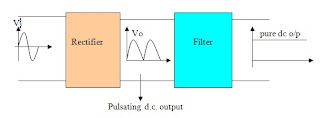 We know that the output of the rectifier is pulsating d.c. ie the output obtained by the rectifier is not pure d.c. but it contains some ac components along with the dc o/p. These ac components are called as Ripples, which are undesirable or unwanted. To minimize the ripples in the rectifier output filter circuits are used. These circuits are normally connected between the rectifier and load as shown below.
We know that the output of the rectifier is pulsating d.c. ie the output obtained by the rectifier is not pure d.c. but it contains some ac components along with the dc o/p. These ac components are called as Ripples, which are undesirable or unwanted. To minimize the ripples in the rectifier output filter circuits are used. These circuits are normally connected between the rectifier and load as shown below.Filter is a circuit which converts pulsating dc output from a rectifier to a steady dc output. In otherwords, filters are used to reduce the amplitudes of the unwanted ac components in the rectifier.
Note: A capacitor passes ac signal readily but blocks dc.
Types of Filters
1. Capacitor Filter (C-Filter)
2. Inductor Filter
3. Choke Input Filter (LC-filter)
4. Capacitor Input Filter (Π-filter)
Capacitor Filter( C-filter)

• When the Input signal rises from o to a the diode is forward biased therefore it starts conducting since the capacitor acts as a short circuit for ac signal it gets charged up to the peak of the input signal and the dc component flows through the load RL.
• When the input signal fall from a to b the diode gets reverse biased . This is mainly because of the voltage across the capacitor obtained during the period o to a is more when comapared to Vi. Therefore there is no conduction of current through the diode.
• Now the charged capacitor acts as a battery and it starts discharging through the load RL. Mean while the input signal passes through b,c,d section. When the signal reaches the point d the diode is still reverse biased since the capacitor voltage is more than the input voltage.
• When the signal reaches point e, the input voltage can be expected to be more than the capacitor voltage. When the input signal moves from e to f the capacitor gets charged to its peak value again. The diode gets reverse biased and the capacitor starts discharging. The final output across RL is shown in Fig.
Advantages of C-Filter
• low cost, small size and good characteristics.
• It is preferred for small load currents ( upto 50 mA)
• It is commonly used in transistor radio, batteries eliminator etc.









